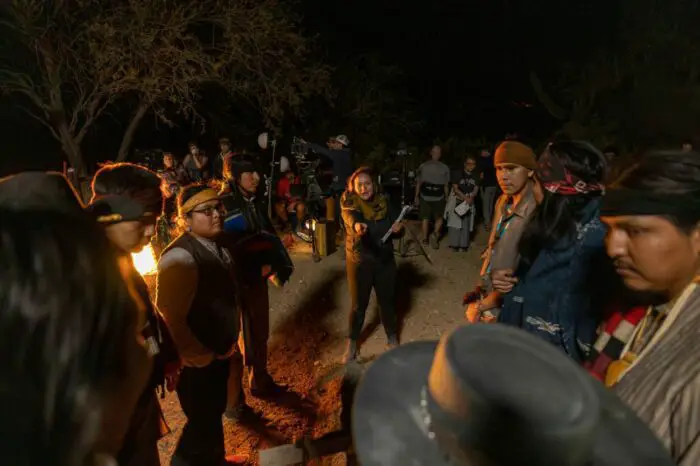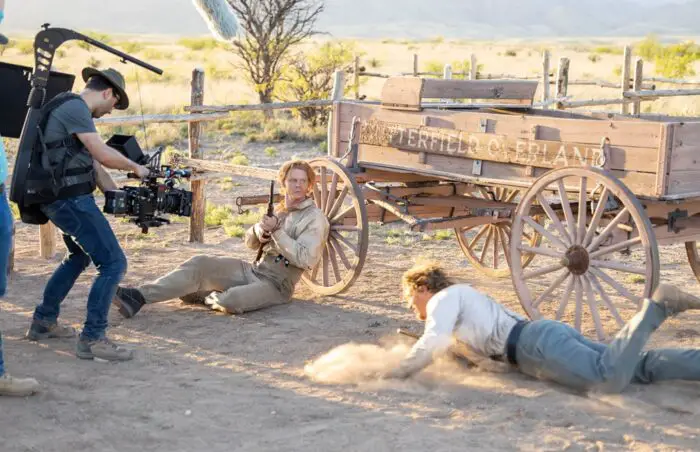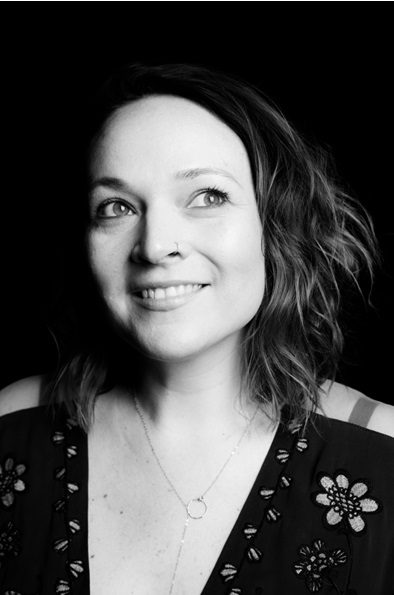Director Deborah Correa’s first feature film, The War Between, takes place during the U.S. Civil War and in the Sonoran Desert of the American West. It’s perhaps unlikely territory for any first-time feature director and for female directors more broadly to take on the Western and war film, two film genres long held dominated by male directors. But Correa, working from a script by Ron Yungul, uses the familiar tropes of those genres to wreak new meanings from them, ones especially timely given our current fraught civic tensions.
In The War Between, two soldiers, one fighting for the North, one for the South, are both stranded in after a battle near Tucson, Arizona. Wary and distrustful of each other, they must learn to navigate the hostile territory while confronting each other’s beliefs and bigotries. But as the two near their destination, others—including women and Indigenous people—play equally important roles in their fates. And the story of two soldiers nearly two centuries ago becomes, appropriately, a meditation on what unites and divides us even today.
Deborah Correa is an award-winning Colombian-American producer and director who was chosen for the prestigious AFI Directing Workshop for Women. Prior to directing The War Between, her work has spanned television, film, and podcasts with both narrative and documentary projects and credits as diverse as PBS, History Channel, Spotify, Travel Channel, iHeartRadio, Brave New Films, and Hulu.
Correa spoke with Film Obsessive publisher J Paul Johnson shortly after The War Between’s debut at the 2024 Phoenix Film Festival. The transcript following the video has been edited for space and clarity.
Film Obsessive: Congratulations on the completion of your first feature film. I’m excited to talk about The War Between, but I’m going to cede the floor to you to let you tell our viewers and readers just a little bit about the plot.
Deborah Correa: Sure. The story takes place and starts from the most Western battle of the Civil War, which took place near Tucson at Picacho Peak. And it’s something that I didn’t know about until the writer and EP Ron [Yungul] told me about it, and I was like, This is fascinating. So the origin of the story starts there at that battle. And from there, it kind of goes into a more fictitious narrative. It’s about a soldier from the North and a soldier from the South who are both stranded in the desert. They find each other and they have to get along to survive. They come across different obstacles and adventures as they get through it. But what I really loved about the script was how it resonates with today. It’s lessons you can apply to the United States and life today.
And you’re just back from Phoenix Film Festival, where the film had its premiere?
That’s right. We premiered to a sold-out crowd. It was a really great experience to premiere where we shot with the community support and with people who live there who didn’t even know about the battle and that it was the setting for the Western battle in the Civil War. And we were also the first film to get approved for the tax incentive and the new tax incentive in Arizona for shooting there. So it was like a big celebration. It was really fun to see all the crew and the cast come out, and we had a great time.
That is really thrilling, and I’m happy it could premiere there. I’m just so intrigued by the film and the production largely taking place in the past, but in a very recognizable area of the U.S. Could you could talk about your locations, props, settings, etc.? Even just the buildings in the film are just so entirely convincing and persuasive.
Oh, thank you, Paul. Yeah. You know, we had a very short amount of time for pre-production, but Film Tucson helped us to scout the locations. And then Tim Flood, our locations manager, had a couple of ideas of where we could shoot as well. So that came together fairly quickly. Went like a month and a half early before the shoot to do the location scout. And I remember just being blown away by the different types of terrain. There’s 4Y Ranch, which is very, like, grassy, then you have the actual Picacho Peak location, which is very mountainous with all the Saguaro cactus. And we also were able to shoot at Old M Cal Studios, which is a setting for old Westerns back in the day. A lot of films were shot there, and right now they’re trying to bring film back to it to revitalize it. But as a set, it was really cool because it feels very desolate. And the depot, that building, Butterfield Stage Depot, was a part of M Cal Studios. We also got to shoot at Old Tucson. So we had, like, mostly exteriors, I would say, and then maybe two or three days with interiors.

How long did the entire shoot take? You did it in 15 days? That is remarkably quick. Efficient, perhaps!
I have to say the trick of it was, I think, really, how talented and great the two actors are all the actors, but Damien and Sam—Damien Conrad Davis and Sam Bullington are the leads—they would get it by the third take. We’d be like, Okay, we’re ready to move on. But also, My cinematographer, director of photography, Evan J. Cohen, I met at Emerson College when we were both in film school. And he was like, Let’s do as much on the boots-on-the-ground prep as possible. So we took a whole entire week, and we photoboarded as much as we could, especially the complicated scenes. We had storyboards for that.
But we photoboarded how we’re going to frame it, what angles we’re going to use, what types of lenses. So we knew what we were going to do before we were there because there was so much open space, a lot of blocking you have to do in that open space. I actually had surveyor flags and I would stick them where we were going to shoot which shot. We had to get that granular with it so we could be as efficient as possible. And there was one of the locations, like, they pulled our flags up and I was like, Oh, my God! How are we going to do this? But we approached it with a more freestyle way and handheld, and it was fine. It worked out fine.
You know, I’m thinking too, you’re at the mercy of the elements out there in the exterior shots, the sun, wind. Were conditions harsh or difficult, or did you experience relatively pleasant time there with your crew?
Well, it’s funny because we did our first day was the battle sequence, and it was the hottest day of that year. On this mountain. The guys are on horses wearing their Civil War jackets, and we had to really deal with the heat and dehydration, make sure everybody had water, and that was very challenging.
And doing the shoot at Picacho Peak was very hard, difficult and very hot. But as we changed different terrains, it became other the wind was a problem at Four Y. So like Apache Springs when they meet, it was like this swirling wind. So sound was a giant issue, you know, it’s constant. And then, sometimes we were out in the middle of nowhere. We had walked quite a bit. We had to watch out for rattlesnakes. We found one rattlesnake, we had to move. And that was challenging just because you’re not close to any trailers or anything. You’re just kind of out in the elements and you rough it and you figure it out, and then you head back. But it kind of also makes you gel as a team more. You feel more united, like you’re doing this together, and I felt very supported by our Arizona crew. They were great. They did it with us, you know. They were there with us through all the heat and the wind and rattlesnakes.

You know, it’s a film that works in some ways in a pretty recognizable idiom. It looks and feels very much like a Western, albeit a Western set in the Civil War. But it’s also a narrative that to me seems to turn midway through from a story of the soldiers to a story of the other people, including women, whose lives are impacted by their service.
Yes. Ron started with this very seed of a story that was about these two guys having to unite to survive. He had referenced Lost in the Pacific (1942). It’s about this Japanese soldier and American soldier who ended up getting along to survive the island. And that was like, I get this dynamic. I know we can make this film. It’s small scale enough where we can probably self-finance and get it made. And then as he wrote it, all of these layers of story came. And it’s just so beautiful. There’s different characters that you meet throughout the story and through flashback and as they’re on their journey. And it really excited me as a director to bring in different textures, you know, shooting with different types of lenses, using like distortion-type things. And I don’t want to give too much of the story away, but I really wanted to have the female perspective through a character as well. Not just my take as a director or that of the two men, and my perspective on war and visual Westerns, but also the female characters and how they would feel and what their journeys would be like in this kind of world back then, too.
I feel like that’s an important and crucial element of the story. And one of the things I really love most about the movie is it’s not it looks and feels like a traditional Western in many ways, but it’s simultaneously both that and more than that. Are you personally a fan of the genre?
I do love Westerns. Well, I would watch them with my grandfather when I was little. And so, The Searchers, My Darling Clementine, older epic, big scope, and then more artistic Westerns, he watched all of them. So I got very close to that genre when I was young. And it also just brings me back to those times with my grandfather watching movies. So it has a very special place in my heart. And Ron said something early on that I just totally resonated with. And he was like, you know, Western is the most uniquely American genre other than film noir. And there’s a lot to do with that because it can be Shakespearean in scope. You know, you can really use it to tell big stories and the more intimate microcosm of what’s going on in history.
And I feel like The War Between is a perfect example of that because you have the backdrop of the Civil War, and then the story of these two guys trying to survive. But they’re on opposite sides.
And it’s a genre that critics at one point said had died in the 1960s, but if it did, it’s been resuscitated and reinvigorated and reinvented in different ways by different directors like yourself in absolutely every decade since. And the visuals still really do pit the protagonists against the environment in ways that I think really no other genre except maybe save for science fiction can.
That’s a really good point. Yeah. And I think it was like we really wanted to approach it as a traditional Western visually so that you have the aesthetics that can speak to this relationship that I feel like a lot of Americans have with it. But then we were telling a more—I wouldn’t call it subversive—but a more progressive story within that structure. And with Evan we did a camera test, and we figured out which lenses we wanted to use. He had these vintage Russian Lomo anamorphic lenses. And when we saw the backdrop of Picacho Peak on those lenses, we were like, Oh, my God, there’s no question. This is what we’re going for. That’s what we’re doing. It just looked like a painting, had a very artistic quality and some like, you know, really textured flares, and we just fell in love with the look of it.
You mentioned too that you had a tax incentive for filming. Is it the State of Arizona or is it in and around Tucson specifically?
It’s the State of Arizona and it just passed. So that’s how we were the first film to qualify for it. And they want to bring film to the state because there’s just so many different types of terrains. And there’s a love for film there. You know, they have the old movie sets, and it was something that gave us a morale boost as well as the financial boost because the community really came together to support the film. And that was great. I mean, you can’t really, like, replace that, right? Because we were near Tucson mostly, Film Tucson was even helping us early on. That’s been a morale boost, their helping with everything across the board, getting the word out, and that is thrilling.
And it’s your first feature film as a director, right? I know you’ve directed for television. I know you’ve directed other kinds of work. You’ve mentioned documentary work. I’m just wondering, is there kind of a special feeling when you set out and start work on your first feature film, maybe on day one, and you’re calling the shots on something you haven’t called the shots on before?
Yeah. I mean, I’ve done a couple of short films, which was great training ground. And also to build confidence to know that I can do it. And I just I just remember pinching myself being like, Oh my God, I’m directing a feature, and I was so scared because it was such an ambitious thing to try to tell this story in 15 days. And all I could do is just put one foot in front of the other and just keep making decisions and moving forward. And as much prep as I could. So it was a dream come true, and I loved the experience of it. The actors were amazing once we found them, as was working with Evan. And the script was just something I felt very connected to, and I knew that we could tell this story. All of it was just a gift, it felt like for me.
I’d like to trace back just your own journey towards it a little bit. So you mentioned film school at Emerson. That’s one stage along that path. And then is there other training as well?
Yeah. So I was accepted into the American Film Institute directing workshop for women, which is like an incubator for directing a short. And that was a great experience to stretch your muscles. And even though the expectations are so now that I look back at them I’m like, Oh, you’re a little bit delusional, thank you. Thinking that it was going to make your career. But it built towards it. Every step has built towards this, and I feel like it gave me that like, Oh, okay, I am a leader, and I can do this, and I’m a director, even though I struggle with confidence and things like that. It’s almost like you can see the artistic collaboration around you and the talent that people are bringing to the film, too, and it is like a true collaboration, and I got a lot of strength from that, too.

And I feel like at AFI you learn so fast. What do they say, drinking from a water hose or something? Like, I was so much because it’s hands on and you do everything like you’re at a studio from start to finish. And Hulu picked up that short that I did there. And you know, I just like I was like, in the middle of it being like, Oh, my God, I got into this program. I was so, like, blown away by that because I had just come to LA. And it was like another like, Wow, this is actually happening. And it was something that I had heard about, so I was Oh, my God, if I can get into this program. That would be huge. And so it was cool. It was definitely a boost.
That’s really exciting. And so The War Between just finished a run at Phoenix Film Festival. What’s next for it and for you?
So, we’re doing the festival circuit with the film probably for the next eight months. And Ron and I we really had a great collaboration on this. He has written another script. It’s a World War Two story. It’s another like lesser known part of our historical past. Is it okay if I pitch it?
Do!
Okay! So it’s the story of a Japanese interned American who helps a German prisoner of war escape in the middle of Colorado. There were prisoners of war camps that we shipped the Germans to during World War Two, and they were right next to Japanese internment camps, and they both worked on the sugar beet fields in Colorado. So Ron has done extensive research and wrote this beautiful script. It’s a love story, but it also shows kind of a darker part of our past that we don’t know a lot about. And I kind of want to just take the time to tell that story, maybe with a little bit more financing and time. And so that’s like our next project. It’s called Fall.
And you imagine that too will be a feature film?
Yes. Yes. That’s the length and the scope that we are looking at.
You know, I love that. And I’m thinking too in terms of the comparison with The War Between and one of the things I love about that film is, I used to teach a course in Westerns as a genre every year in my career. And I enjoyed doing so very much. And my students would frequently come in thinking, Oh, these are the films my grandfather used to watch. But they would quickly learn that the Westerns were not really just about the Old West, but that they were about the times in which those films were made. Whether they were the from the 1940s, whether they were the 1960s or whether they were the 2010s. All of them were reflecting on their current moment.
And, boy, there’s more than one time and more than one moment in The War Between where I’m called upon to do exactly that, and think about these two men having grown up in very different circumstances and very different belief systems to the point where they can really no longer imagine themselves to be part of the same country. And it’s a thought that really resonates with me today, and just the prospect that you’ve described for your new project sounds like it will have that same kind of resonance and meaning with audiences, looking at it through a contemporary angle.
Yeah, I love that. I love that analysis of it and how, you know, with The War Between having the Western as a backdrop to tell a story for today. That was big for us, and it shows you how we really need to focus on our shared humanity and not the differences because we all have our blind spots. And I think that you know, as you watch the film, there’s little things throughout it that you can put towards what’s happening politically today and within our country.
I’m excited for The War Between to gain a wider audience as it continues its path through film festivals over the next eight months and excited to see what comes up for you in the future, Deborah. Thank you for taking the time to speak with us today.
Thank you, Paul. It’s so great. Appreciate it.



